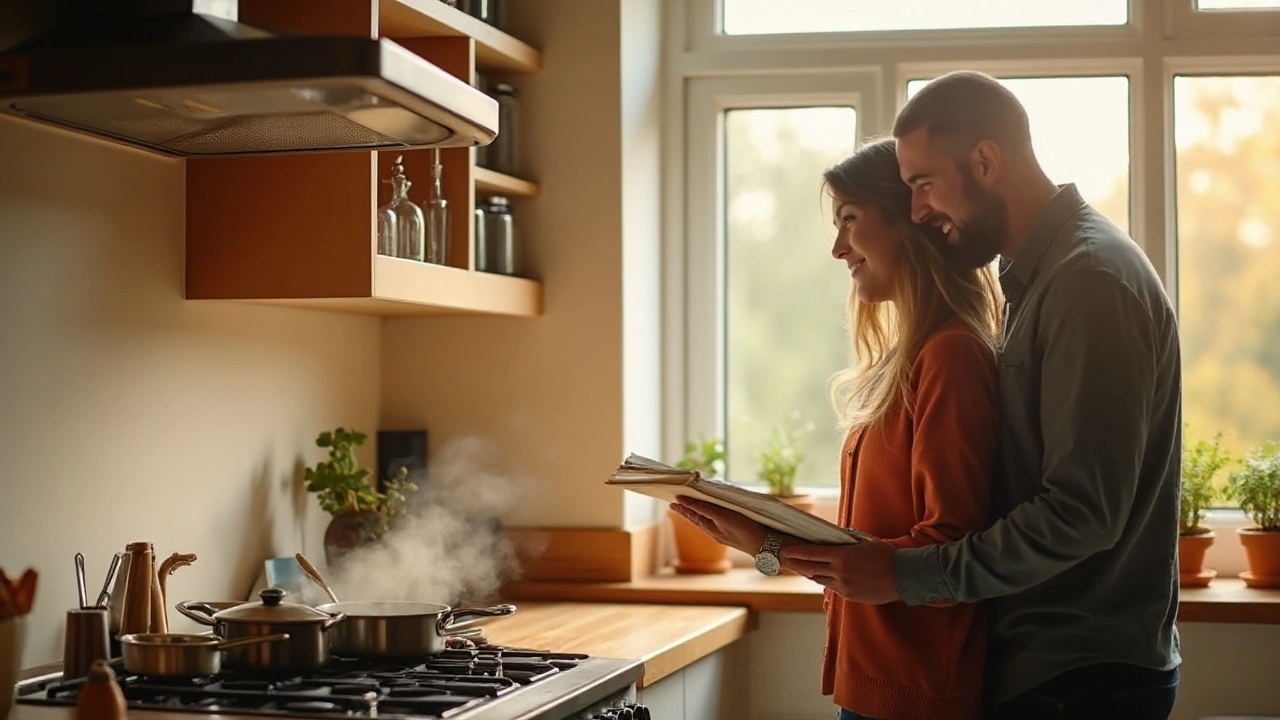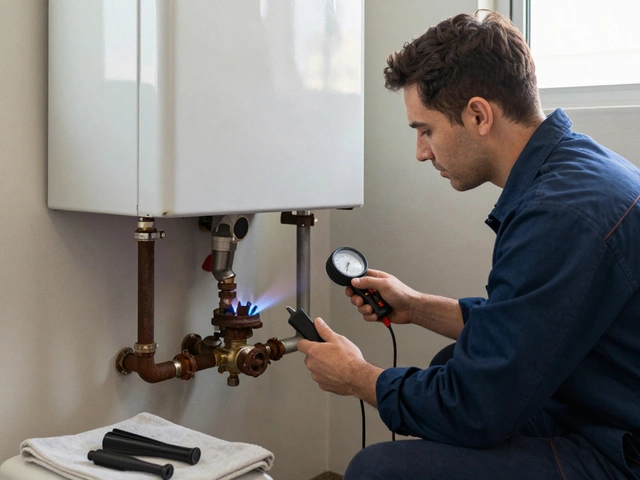Understanding the necessity of an extractor fan in your kitchen may seem straightforward, but when legal requirements come into play, it adds a new layer of complexity. Proper ventilation is a cornerstone to maintaining a safe and healthy kitchen environment, but do you legally need an extractor fan? We explore the key regulations, health risks, and the benefits associated with having an efficient extractor fan installed.
Kitchen ventilation goes beyond merely clearing unwanted odors, playing a significant role in regulating air quality and preventing mold or heat-related damages. While laws might differ depending on where you reside, knowing the specifics can help you adhere to bylaws and ensure the safety of your home.
Even if an extractor fan isn't legally required in your area, the advantages of having one are worth considering. We'll provide practical advice on choosing the right system for your space and maintaining it effectively. Plus, we touch upon alternative solutions for enhancing ventilation should traditional systems be lacking or impractical.
- Legal Requirements for Kitchen Ventilation
- Health and Safety Benefits of Extractor Fans
- Alternatives to Traditional Extractor Fans
- Tips for Maintaining Your Kitchen Ventilation System
- What to Do If an Extractor Fan Isn't Installed
Legal Requirements for Kitchen Ventilation
Kitchen ventilation is a critical component of home safety and health, but the legal requirements surrounding it can often seem murky. Depending on where you live, the regulations might vary significantly. In the United States, for instance, building codes can change from one state to another, even from city to city. Generally, the International Residential Code (IRC) serves as a guide, recommending effective ventilation in places where cooking appliances are used. This doesn't always mean an extractor fan is obligatory, but adequate means to expel smoke, moisture, and odors are usually mandated.
In the United Kingdom, building regulations are more stringent. Here, mechanical ventilation — typically achieved through extractor fans — is often a requirement in new builds and major renovations to comply with Document F of the Building Regulations. The primary aim is to prevent health risks associated with indoor air pollution. Neither laws nor guidelines take these matters lightly, as poor ventilation has been linked to respiratory problems, something no homeowner wants to risk. It is crucial to consult local building authorities or a knowledgeable contractor to ensure compliance with all pertinent regulations.
When considering the requirements, it's not merely about ticking boxes on a regulatory checklist. There’s a direct impact on property value and insurance eligibility as well. Homes that adhere to modern standards regarding kitchen ventilation can command higher prices. Home insurers may also offer better terms to properties that have necessary safety mechanisms like proper ventilation in place, minimizing the risk of damage from lingering smoke or excess moisture.
Building Code Interpretations and Clarifications
While some might find building codes somewhat overwhelming, especially when delving into the specifics of kitchen fan regulations, it's crucial to understand the reasoning behind these rules. Not only do they ensure occupant safety, but they also aim to promote energy efficiency. Ensuring that airflow systems complement energy-saving initiatives can significantly reduce utility bills and environmental impact. Therefore, understanding the intricacies of these codes can be beneficial.
Indeed, guidelines often include the necessity for noise level management, thermal comfort, and air quality measurements — all factors that contribute to the optimal functioning of a home. Given the variations across borders, many homeowners find it beneficial to engage with local building professionals. They can provide insights into both the spoken and unspoken expectations of local regulators. This approach spares you from potential headaches that could arise during building inspections or when reselling the property.
"Effective kitchen ventilation isn't just about legal compliance; it's about maintaining a healthy living environment inside your home," says Thomas Greene, a senior consultant at the Home Ventilation Society.
Considering all this information, it's evident that understanding and adhering to legal requirements for kitchen ventilation is in the homeowner's best interest, both for financial reasons and for the health benefits. Whether or not laws explicitly demand an extractor fan, having one can provide peace of mind. It's advisable for homeowners to consult local guidelines pertinent to their locality and seek advice from trusted contractors to ensure compliance and maximize benefits.
Health and Safety Benefits of Extractor Fans
When it comes to maintaining an optimal living environment, having a proper ventilation system is crucial. An extractor fan plays a pivotal role in ensuring good indoor air quality, especially in the kitchen, where fumes and odors are part and parcel of daily cooking activities. One of the major health benefits of an extractor fan is its ability to reduce indoor pollutants. During cooking, harmful substances like carbon monoxide and nitrogen dioxide may be released. These pollutants can lead to health complications, particularly for individuals with respiratory issues.
Beyond removing these gases, a kitchen extractor fan helps in decreasing humidity levels. High humidity is often the culprit behind mold growth, which can cause an array of health issues, from allergic reactions to more severe respiratory problems. An extractor fan efficiently removes moisture from the air, curbing the growth of mold and mildew within kitchen spaces. This is vital in keeping surfaces, walls, and ceilings free from mold contamination.
An often overlooked aspect of extractor fans is their ability to dispel unwanted heat from cooking appliances. Excessive heat can not only make the kitchen uncomfortable but can also put a strain on other electrical devices, potentially leading to malfunctions or even fire hazards. By keeping the temperature regulated, extractor fans contribute significantly to the safe operation of kitchen appliances in the long run.
Another aspect to consider is the reduction of lingering cooking odors. While touching on safety might be the focus, comfort cannot be understated. Cooking fish or deep-frying foods might leave your home smelling less than pleasant for hours or even days. An efficient extractor fan helps manage odors by swiftly removing them from the kitchen area, ensuring your home maintains a fresh and inviting atmosphere.
Kitchen ventilation systems also provide a practical solution for allergen-sensitive individuals. By filtering and removing pollen, dust, and other particles from the air, these systems create a cleaner indoor environment. It's noteworthy that well-maintained homes are generally healthier. This is where extractor fans shine, as they are instrumental in keeping the air free of contaminants, significantly reducing allergy triggers indoors.
It's not just homeowners who advocate for improved ventilation. Experts, like those from the Environmental Protection Agency (EPA), emphasize the importance of maintaining air quality, particularly in confined areas like kitchens.
“Ensuring proper ventilation in enclosed spaces like the kitchen can significantly improve indoor air quality and overall wellbeing,”says a report by the EPA. This stance highlights the widespread acceptance and importance of extractor fans as a preventative measure in housing standards.
In summary, the health and safety benefits of extractor fans extend beyond mere convenience. They safeguard against various environmental factors that could otherwise impact one's health. For those undertaking kitchen renovations or looking to improve air quality, considering the installation or upgrade of these fans could have lasting positive effects on their home’s environment.

Alternatives to Traditional Extractor Fans
When discussing alternatives to traditional extractor fans, it's important to understand the wider landscape of kitchen ventilation methods. In recent years, technology and architecture have combined forces to offer intriguing solutions. One such innovation is the downdraft extractor, a marvel of modern engineering. Unlike the hood-mounted fans that protrude from above, these systems are hidden within the cooktop itself, rising only when in operation. They’re particularly attractive in open-plan kitchens where a central hood might obstruct sightlines or disrupt design aesthetics. This approach not only retains the kitchen's design charm but also ensures effective ventilation.
Then, there's the option of recirculating cooker hoods, which have gained popularity for their ease of installation and adaptability. These systems filter the air before recirculating it back into the kitchen, rather than venting it outside. Recirculating hoods often use carbon filters to trap particulates and absorb odors, which presents a viable option where external venting isn’t feasible, such as in apartment settings. Additionally, they are often more energy-efficient, conserving the home's heat rather than expelling it.
Yet another emerging favorite is the fresh air intake system, ideal for those concerned about energy bills and sustainability. They introduce fresh outdoor air into the kitchen while simultaneously expelling stale air. Often integrated with home HVAC systems, these setups can be customized to match the kitchen’s specific requirements. Such systems ensure the home remains energy efficient as they allow heat recovery, which is an attractive feature in colder months.
For those inclined towards a more natural approach, strategically placed windows or vents can significantly boost kitchen ventilation. This method leverages cross-ventilation, which is particularly effective in climates where controlling excess humidity isn't a pressing concern. Local building codes sometimes require that kitchens have at least one operable window or vent that directly exhausts to the outside. Nonetheless, it's imperative to combine this with fans or other active systems to deal with particulate matter effectively.
In Sweden, a study revealed that natural ventilation, when combined with high-quality filters, could capture up to 80% of PM2.5 particles, akin to some mechanical systems. Thus, even passive systems can play a significant role in maintaining air quality. That study aligns with findings from other developed nations exploring similar methodologies.
"Many homeowners prefer alternative solutions that blend seamlessly into their living spaces. Balancing aesthetics with functionality is the essence of modern kitchen design." — Emily Robeson, Architectural Digest
This wealth of options allows homemakers to select kitchen ventilation methods that cater not only to legal and health requirements but also align with their personal tastes and home configurations. Such advancements in ventilation technology signify a shift where the kitchen not only serves culinary pursuits but becomes an extension of the home’s overarching design philosophy.
| Ventilation Type | Pros | Cons |
|---|---|---|
| Downdraft Extractors | Space-saving, elegant design | Higher initial cost, limited effectiveness with larger cooking areas |
| Recirculating Cooker Hoods | Easy installation, energy-efficient | Filter replacements needed, less effective at smoke removal |
| Fresh Air Intake Systems | Improved air quality, energy-efficient | Complex setup, potential higher maintenance |
| Natural Ventilation | No energy costs, simple implementation | Weather-dependent, not always sufficient alone |
Tips for Maintaining Your Kitchen Ventilation System
Keeping your kitchen ventilation system in prime condition is essential not only for a fresh-smelling home but also for the overall health and safety of your living environment. Regular maintenance of your kitchen ventilation system can extend its lifespan and improve its efficiency, saving you money and reducing energy consumption. Begin by creating a maintenance routine that fits into your schedule, making it easier to keep track of essential tasks.
Regular Cleaning
The first step in maintaining an extractor fan is frequent cleaning. Grease and grime can build up over time, hampering the fan's efficiency. Use warm soapy water and a soft cloth to wipe down the exterior each month. Don't forget to clean the fan's blades and filters; this task might require a Phillips screwdriver for safety grilles. Some filters are dishwasher-safe but check the manufacturer's manual to avoid damage.
"A poorly maintained extraction system can negatively impact indoor air quality. Regular check-ups and thorough cleaning routines are critical," states John Simmons, an HVAC expert with over two decades of industry experience.
Inspecting Components
Inspect the key components of your extractor fan periodically. Look out for wear and tear in the fan's motor, and listen for unusual noises which can indicate mechanical issues. Pay attention to the power supply and ensure it operates smoothly without flickering. Address any concerns immediately to prevent further damage. For kitchens with more expansive ventilation systems, considering professional inspections once a year might be beneficial. These experts can identify issues that are not obvious to the untrained eye.
Replacing Parts
Some parts of your kitchen fan, such as filters and bulbs, may need replacing more frequently. Charcoal filters typically require replacement every three to six months, especially if your cooking produces a lot of fumes. Consistent replacement ensures efficiency and better odor control. Following your system's specific guidelines will help maintain peak performance. Habitually set reminders to check these components and replace them as necessary to avoid lingering stale smells or diminished extraction capabilities.
Utilizing Technology
Modern extractor fans often come equipped with technology that can assist in maintenance. Use of sensors can alert you to possible issues like reduced airflow or blockages. Adjusting settings to match your cooking habits can also save energy. As technology advances, simple smartphone apps can now sync with ventilation systems, providing notifications for tasks such as filter cleaning and servicing times. Utilizing these technological advancements can ensure that your kitchen remains a safe and pleasant space.
Monitoring and Adjustment
Regularly check and adjust the settings on your ventilation system to match your cooking needs. A higher setting might be appropriate for cooking methods like frying or grilling, which produce more smoke. Monitoring your kitchen fan's performance and making necessary adjustments can significantly reduce energy consumption and improve its effectiveness. Always refer to the manufacturer's handbook for optimal settings tailored to your specific fan model.
| Task | Frequency |
|---|---|
| Cleaning fan blades and exterior | Monthly |
| Replacing carbon filters | Every 3-6 months |
| Professional inspection | Yearly |
| Monitoring system performance | Ongoing |
Maintenance should not be an afterthought but a continuous process that ensures both efficiency and safety. By following these best practices, your kitchen ventilation system will remain reliable, promoting a healthy and pleasant atmosphere.

What to Do If an Extractor Fan Isn't Installed
Finding yourself in a kitchen without an extractor fan can be unsettling, especially when thinking about persistent odors and potential health risks. But fear not; there's a range of solutions to explore. It's quite essential to first determine the current ventilation standard in your kitchen. Without a fan, a properly placed window capable of facilitating natural air flow is the next best alternative. You might be surprised at the effectiveness a strategically opened window can have, drawing out steam and foreign smells. Complement this with a ceiling vent for more pronounced airflow control. This combination can significantly decrease airborne grease, smoke, and heat accumulation, promoting a healthier atmosphere.
For homeowners who wish to install an extractor fan but face financial constraints, there are resources available to assist with costs. Some localities offer grants or subsidies for home improvements aimed at enhancing safety standards. It's worth investigating your local council's offerings or utility company rebates, which might cover part of your extractor fan necessity. Donning a DIY hat can also be an option, though professional installation is recommended for safety reasons. If you're inclined to do it yourself, be sure to choose a fan model appropriate for your kitchen size and layout, ensuring compatibility with your existing infrastructure is vital.
Alternative options? Absolutely. Consider devices like air purifiers or dehumidifiers, which assist in keeping the air fresh and more breathable. While they don't typically provide the same level of power as an extractor, they can most certainly make a difference to your kitchen ventilation. Look for carbon filter options—these are excellent at neutralizing odors by trapping particles and gases. Moreover, adding houseplants known for their air-cleaning qualities could boost your efforts while also adding some greenery to your space.
In some cases, installing a recirculating fan might suffice. These systems work by pulling in air, filtering it within the unit, and venting it back into the kitchen. Though perhaps not as effective as ducted systems, they're suitable for spaces where it's impractical to install ducts. It's a temporary fix, and from a technical standpoint, the system may require frequent maintenance. According to Erica Holmes, a renowned architect on sustainable homes,
"Recirculating fans can be a practical and eco-friendly alternative for city apartments, given they’re regularly cleaned and maintained."
Finally, proper maintenance of any installed system, even the makeshift ones, is essential. Regular cleaning and filter replacements ensure optimal performance. Consider scheduling reminders to clean filters bi-monthly to avoid buildup obstructing airflow. Keeping this in mind, a balance of thorough upkeep and strategic additions to your ventilation can maintain pleasant and safe living conditions. Remember, visible steam and lingering smells are your cue to act swiftly and effectively to keep your home environment safe and comfortable.





